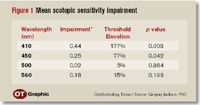Article
Scotopic vision may be affected by blue-blocking lens
Washington, DC—An IOL that blocks blue light leads to impairment of scotopic vision at the short wavelengths important for rod-mediated vision. The significance of this impairment in terms of the patient's visual performance remains to be determined, explained Gregory Jackson, PhD, at the American Society of Cataract and Refractive Surgery annual meeting.

Future research should determine if this impairment is related to problems with mobility in conditions of dim light, Dr. Jackson said. He is assistant professor of ophthalmology, department of ophthalmology, University of Alabama at Birmingham.
Rod-mediated or scotopic vision depends more on blue wavelengths of light than does cone-mediated or photopic vision, Dr. Jackson explained. Therefore, the impact of an IOL that blocks blue light is important to determine.

Of greater importance, however, is that poor night vision is linked to involvement in motor vehicle collisions and falls that result in injury. These deficits in night vision are exacerbated further in patients who have age-related macular degeneration (AMD) and diabetic maculopathy.
Blue-blocking IOLs may add to this deficit by reducing blue-light transmission, Dr. Jackson said.

"The hypothesis behind this study of the 20-D AcrySof Natural lens (Alcon Laboratories) is that the IOL significantly impairs rod-mediated vision as measured by scotopic visual sensitivity," he said.
In this cross-sectional study, Dr. Jackson and colleagues compared the scotopic sensitivity of patients with an ultraviolet-only-blocking control IOL implanted (n = 16) with that in patients with the blue-blocking IOL implanted (n = 11). The demographic data of the two groups were similar; the mean age of the patients with the clear IOL implanted was 69.3 years and that in the group with the AcrySof Natural lens implanted was 68.1 years.
Scotopic sensitivity testing Before testing the scotopic sensitivity, both groups of patients were adapted to the dark for 40 minutes. The detection thresholds for a Goldmann size V target were tested at wavelengths of 410, 450, 500, and 560 nm. The test locations were at 7° eccentricity on each visual axis.
Newsletter
Don’t miss out—get Ophthalmology Times updates on the latest clinical advancements and expert interviews, straight to your inbox.




